This was my first decent Jupiter photograph (in October 1999), taken with my Vivitar 35EM compact, afocal with a 10 mm eyepiece on my C8. It shows a shadow transit of Io, at the very bottom of the disc.

Planet and other Solar System Images 1999 to 2003
|
This was my first decent Jupiter photograph (in October 1999), taken with my Vivitar 35EM compact, afocal with a 10 mm eyepiece on my C8. It shows a shadow transit of Io, at the very bottom of the disc. |
 |
|
Before I got the VCam, I took some sequences with a Canon UC15 Video Camera. Later frame capture and processing yielded these images. R.J. Stekelenburg's AstroStack program was invaluable in processing the ten second AVI clips which each yielded around 100 frames. |
 |
|
Saturn has proved a difficult subject. Although I took numerous frames with the VCam, none processed as well as a Video Camera clip, also on December 13th. Here it is, some banding apparent, and a hint of Cassini's Division. |
 |
|
Once I started imaging with the Vcam, I was able to take multiple images, then combine and process them. The next picture was a pleasing result, processed using a trial version of MaximDL. |
 |
|
This pair of images was overexposed to show the moons. Because I wasn't looking for detail, they are just single shots. It's interesting that to capture the moons with the Vcam I have to overexpose the planet, whereas the Video camera is ok. I think it's to do with the 6 bit operation of the Web Camera limiting the dynamic range of the images. |
 |
|
The following set is of particular interest. The conjunction of Jupiter and Venus on 17th. May 2000 was almost a transit - only 20 arc seconds seperation between the planetary discs at closest approach. BUT it was during the day in the UK, at 1030 UST (1130 BST). The weather here on the few days preceding the event was very hazy, but with a cold front due to pass through the night before, I hoped for clean skies. Indeed they were - in between quickly moving clouds! Sod's law came into full effect, and there was never a long enough clear patch near closest approach for me to find Venus and align the camera. Eventually however a large clear area opened up around 1215 (1115 UST), and I was able to image for about 6 minutes from 1217 to 1223, getting over 100 images. Venus was crisp and clear, and nearby a faint pale circle was Jupiter. The seperation by then was about 100 arc seconds. Venus at that time was only 6.5 degrees from the Sun! I used the Baader Solar Film Sun filter while aligning the telescope on the Sun, then setting circles to move to Venus' position before removing the filter. The images were taken using the VCam at prime focus of the Celestar 8" SCT. The second picture is a false colour version of the centre one in the group, processed by Steve Wainwright of QCUIAG. The right hand picture is a composite of all the images, stacked in 1 minute blocks, then overlaid in Adobe Photoshop, using Jupiter as the reference. This also shows the movement of Venus over the 6 minute period, and a hint of two bands on Jupiter. |
 - - - - |
|
The early hours of August
28th. saw me under clear skies at home, imaging deep sky
with my Grayscale
and planets with my Vcam.
Seeing was very stable, |
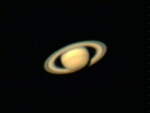 -- --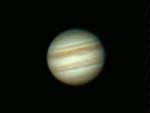 |
|
Yet another damp night on 4th. September giving good seeing and more images of Saturn and Jupiter: |
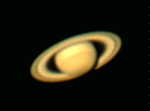 -c -c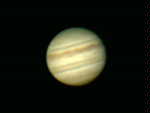 |
|
9th. October 2000 saw me up very late, and this image of Jupiter, my first red spot of the apparition, was obtained in good seeing at 5.26 am local time! (0426 UST). Vcam + 2x Barlow, 8" SCT |
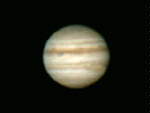 |
|
In January 2001, Venus was a bright jewel in the evening sky, and a combination of several images, all rather blurry in turbulent air on a cold evening of 13th. produced this picture. No cloud detail seen, but unmistakeably half phase! See below for more photos! |
 |
The early 2001 apparition of Venus gave us
several weeks of a superbly beautiful Evening Star, a bright beacon
at a magnitude
of -4.6 for most of February. Here is a selection of photographs
taken using the Vesta Pro Web Camera and 3x Barlow on the C8,
showing the change in shape and size as conjunction approached.
|
|
|
|
 |
 |
 |
|
|
|
|
 |
 |
 |
|
The pre dawn hours (around 6 am) of October 4th 2001 promised a shadow transit of Io coupled with a emergence from occultation of Ganymede. I was able to capture this before the sky lightened. |
 |
|
Around 6 pm on 26th. January 2002 there was a superb occultation of Jupiter by the Moon. Although the Moon was near full, the occultation from the North of England was a near graze, consequently the entry phase showed lunar detail as well as three major satellites and banding on Jupiter. Note the peculiar flooded plateau crater Wargentin. The block of pictures shows the entire event over a span of 35 minutes. All with Vesta Pro web camera at prime focus of the LX90. |
|
On 7th. May 2003 Mercury transited the face of the Sun. I was on holiday in Ambleside in the English Lake District, and although I went out early (up a mountain pass!) to try for the early stages, it was clouded over. But later stages from the hotel lawn :-) were nice and clear, and I obtained several images. The still frames here (linked as usual to larger versions) were both single frames, the exit frame being taken at full optical and digital zoom of my Olympus 2100UZ camera through the 40 mm eyepiece on my AT1010 (mounted on undriven EQ3-2 equatorial mount). There are also DivX codec AVI's of the transit and exit stages . Transit (52 KB) here, Exit (8.5 KB) here. Depending on the configuration of your browser, you may need to download the AVI's before you can view them. |
|
MARS made its closest approach to the Earth for almost 60,000 years at the end of August 2003. Unfortunately rather low in the sky in the UK, and my earlier images were not worth displaying. But the early hours of 6th. August with the planet's disc approaching 23 arc-seconds in diameter , despite difficult conditions with the image continually 'morphing' yielded this barely acceptable merge of 570 frames. The enlargement also shows a simulation from Mars Previewer |
|
In the early hours of 14th. August, Mars was starting to ride high (well, almost 20 degrees), so as soon as it appeared around the corner of my neighbours house, it was webcam time! I took several .avis, and eventually produced this image from around 2500 frames. Much better colour and shape than my previous attempt, but I was still hoping for further improvements before this very close approach was over - I might not be around (in 2020) for the next one! The enlargement also shows a simulation from Mars Previewer. |
|
High Pressure became established for a couple of days , and I obtained this image of Mars early on 23rd. August. Still troubled by atmospherics, but more features identifiable using Mars previewer (click on thumbnail).
|
|
More stable again early on 24th. August, and my best yet, with the South Polar Cap showing some signs of fragmentation. Closest in a couple of days, but the weather forecast is poor :-( |
|
After a few cloudy nights, the night of 29/30 August had numerous clear spells, so I took another avi of Mars. But seeing was poor, so the image only shows the broadest features.
|
|
Fairly still conditions, but dappled thin cloud dimmed the contrast early on 2nd. September. A little more detail than 30th. August, but only just! Nevertheless, it is very obvious how much the South polar cap has shrunk over the three weeks since my first image of 6th. August. |